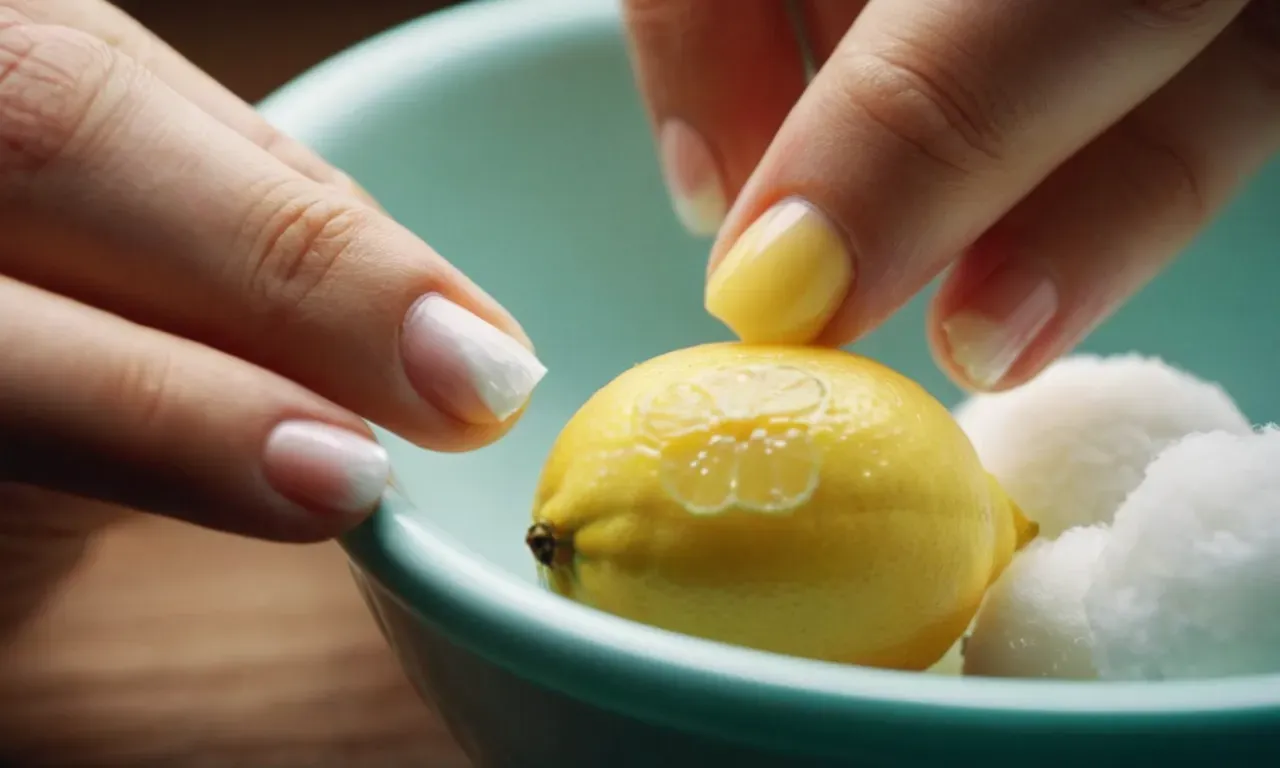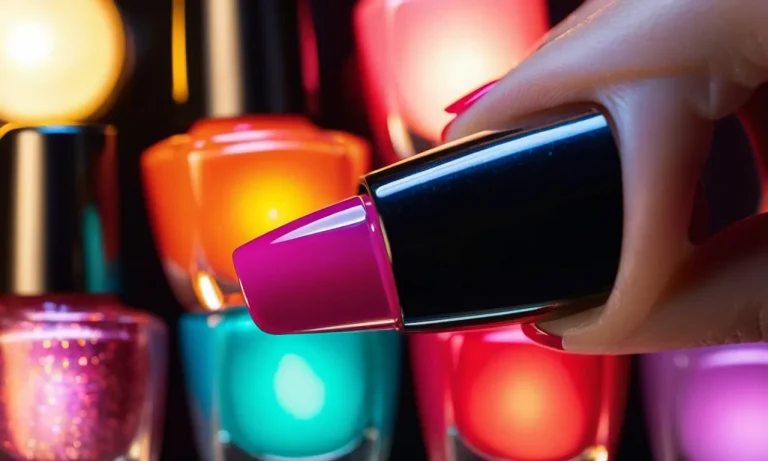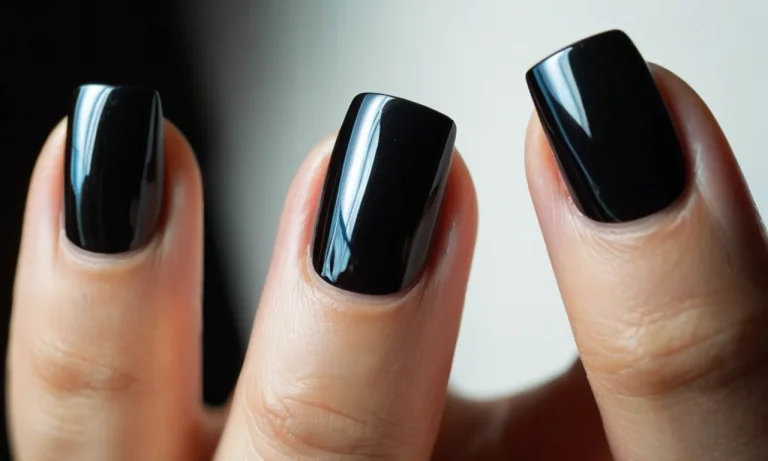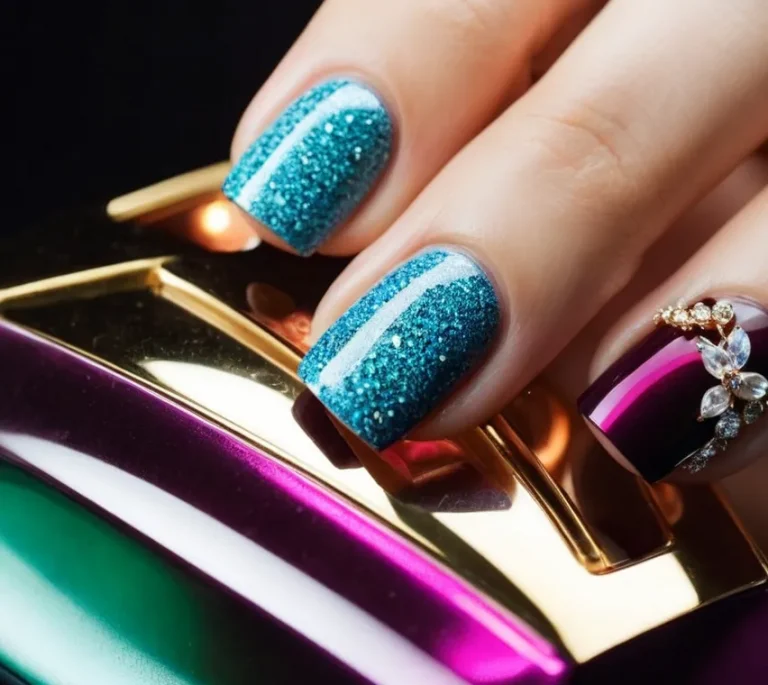How To Remove Nail Polish Naturally: 10 Simple Methods
Beauty trends come and go, but a classic, polished manicure never goes out of style. However, all good things must come to an end. When it’s time to remove your nail polish, you don’t need harsh chemicals to get the job done.
In fact, you likely have everything you need in your pantry and medicine cabinet to safely and effectively remove polish without irritating your skin or nails.
If you’re short on remover and need to take off your nail polish quickly, try rubbing your nails with a cotton ball soaked in oil or vinegar. The oil/acid will break down the polish so you can gently scrub it away.
Use Oil
Olive Oil
Olive oil is a natural and gentle way to remove nail polish without exposing your nails to harsh chemicals. Here are some tips for using olive oil:
- Soak a cotton ball or pad in olive oil and hold it against your nail for 30-60 seconds. The oil will help break down the nail polish.
- Gently rub the cotton pad back and forth across your nail to remove the polish. You may need to use a few cotton pads to get it all off.
- For very stubborn polish, soak your entire finger in a bowl of olive oil for 3-5 minutes. This gives the oil more time to dissolve the polish.
- Use a soft toothbrush or nail brush dipped in olive oil to gently scrub off any remaining flecks of polish.
- Finish with a swipe of fresh olive oil to condition your nails.
The monounsaturated fats in olive oil help nourish nails and cuticles, leaving them smooth. It’s also antimicrobial, so it helps prevent infections around the nails. Just be patient removing polish with olive oil—it takes a little more effort than acetone but is much gentler.
Coconut Oil
Like olive oil, coconut oil can break down nail polish without the harsh chemicals. Here’s how to use it:
- Apply a generous amount of coconut oil over your nails and let it soak for 2-3 minutes.
- Gently rub the oil over your nails in a circular motion to dissolve the polish.
- Take a cotton pad and wipe away the polish and oil mixture.
- Repeat with fresh coconut oil and cotton pads until all traces of color are gone.
- Rinse nails with water and pat dry.
Coconut oil has mild antifungal and antibacterial properties to help keep nails clean. It also deeply moisturizes nails to prevent brittleness and cracking. Be sure to use pure, virgin coconut oil for the best results.
Almond Oil
Almond oil is an emollient oil that can gently break down nail lacquer. Follow these tips for using it:
- Apply a few drops of almond oil onto each nail and let it soak in for 2-3 minutes.
- Take a cotton ball and gently rub back and forth over each nail to remove the polish.
- You may need to use a few cotton balls to remove all traces of color.
- For stubborn glitter polishes, let the oil soak longer, then use a soft brush to gently scrub particles away.
- Rinse nails with water and apply a final layer of almond oil to condition nails.
Almond oil is rich in vitamin E, an antioxidant that protects nails from damage. It also has emollient properties that keep nails flexible and prevent splitting and peeling. When removing polish with almond oil, be patient and let the oil fully dissolve the lacquer before wiping.
Try Vinegar
White Vinegar
White vinegar is a mild acid that can help break down nail polish and remove it from the nail plate. It’s a great natural alternative to harsh nail polish removers.
To use white vinegar:
- Soak a cotton ball or pad in undiluted white vinegar
- Press it onto your nail and hold for 1-2 minutes to allow the vinegar to penetrate the nail polish
- Gently rub the nail surface to help lift the polish
- Rinse your nails in water
- Repeat if needed for stubborn polish
The acetic acid in vinegar dissolves the nail lacquer ingredients over time. It may take a few applications, but with some elbow grease, white vinegar can erase even the darkest shades of polish.
Apple Cider Vinegar
Like white vinegar, apple cider vinegar (ACV) contains acetic acid that can break down nail polish. Some people find it to be more effective than white vinegar.
Follow the same method as above, using undiluted ACV instead of white vinegar. The main difference is that ACV has a fruity aroma that some people find more pleasant than white vinegar’s pungent smell.
In addition, ACV offers other benefits for nail health:
- Its anti-fungal properties prevent fungal nail infections
- It clears away dead cuticle skin
- The acidity helps kill nail bacteria
So while both vinegars work to erase polish, ACV pulls double duty by also improving nail health and appearance.
Make a Baking Soda Scrub
Baking soda is a gentle yet effective ingredient that can help remove nail polish naturally. Here are some tips for making a simple baking soda scrub to remove nail lacquer:
Ingredients
- 2 tablespoons baking soda
- 1 tablespoon liquid soap or shampoo
- 1 tablespoon water
Steps
- In a small bowl, mix together the baking soda, liquid soap, and water until it forms a spreadable paste.
- Apply the mixture over nails covered in polish. Gently scrub nails for 2-3 minutes.
- Rinse thoroughly with warm water. Use a soft brush or cotton pad to gently remove any remaining nail polish.
- Pat nails dry with a towel.
- Apply a nourishing oil like olive oil or coconut oil over nails to condition them.
Baking soda works to break down nail lacquer because it is a mild abrasive. The granules help gently buff away the polish. Baking soda also helps neutralize odors and soften nails. A review in the Journal of Cosmetic Dermatology found baking soda scrubs to be effective at removing nail polish without damaging the nail plate.
Some tips when using a baking soda scrub:
- Add more baking soda if the scrub isn’t gritty enough to remove darker polishes.
- Use liquid castile soap for a more moisturizing effect.
- Don’t scrub too hard or for too long to avoid weakening nails.
- Rinse nails thoroughly after scrubbing.
- Follow up with a moisturizer for healthy looking nails.
Baking soda nail scrubs provide an easy, non-toxic way to gently remove nail lacquer at home. Pair the scrub with some warm water and gentle rubbing to see polished nails transform back to their natural state. For an even more effective removal, try soaking nails in pure lemon juice prior to scrubbing.
Use Citrus Fruits
Lemon Juice
Lemon juice is one of the most effective natural nail polish removers. The high acidity of lemon helps break down the nail polish and remove it from the nails. Here are some easy methods to use lemon juice for removing nail polish:
- Cut a lemon in half and squeeze the juice directly onto your fingernails or toenails. Let it sit for a few minutes before scrubbing the nails with a cotton ball.
- Mix equal parts lemon juice and warm water. Soak your nails in this solution for 10-15 minutes. Then, gently scrub the nail polish off with a soft brush.
- Make a paste by mixing 2 tablespoons of lemon juice with 1 teaspoon of baking soda. Apply this mixture to your nails and let it sit for 5 minutes before scrubbing off with a toothbrush.
The citric acid in lemon works to break down the nail lacquer. Lemon juice also has bleaching properties that can help lighten nail stains. Just be careful not to overdo it, as the acidity in lemons can dry out the nails.
Orange Juice
Like lemon juice, orange juice also contains citric acid that can dissolve nail polish. Some easy tips to use orange juice for nail polish removal:
- Soak a cotton ball in fresh orange juice and hold it against your nails for 2-3 minutes. Gently rub the wet cotton ball back and forth across each nail to remove the polish.
- Mix equal amounts of orange juice and baking soda to make a thick paste. Apply this homemade scrub onto each fingernail and let sit briefly before scrubbing off.
- Fill a bowl with orange juice and submerge your fingertips in it for 10 minutes. Then, use a soft brush or toothbrush to gently exfoliate off the polish.
The vitamin C in oranges helps soften the nail lacquer for easy removal. This method is gentler than using harsh acetone removers. Just be sure to moisturize nails after to prevent dryness.
Lime Juice
Like other citrus fruits, lime juice contains acidic compounds that can dissolve nail polish quickly and easily. Some effective methods are:
- Apply fresh lime juice directly onto nails using a cotton ball or squirt bottle. Let sit for several minutes before scrubbing off.
- Mix equal parts lime juice and olive oil. Soak nails in this solution for 15 minutes, then scrub off using a soft-bristled nail brush.
- Combine 2 tablespoons lime juice, 1 tablespoon baking soda and 1 tablespoon salt. Spread this mixture onto nails and allow to sit for 5 minutes before rinsing.
The natural bleaching agents in lime juice can also help whiten yellowed nails. Just avoid over-exposing nails to the acidity, as it can cause dryness. Moisturize nails after removing polish.
Rub With Toothpaste
Toothpaste can be an effective yet gentle nail polish remover you likely already have at home. The gritty texture combined with ingredients like baking soda or hydrogen peroxide provide an abrasive yet non-damaging scrub to lift color off nails.
How It Works
When rubbed on painted nails, toothpaste uses tiny abrasive particles and mild chemicals to break down nail polish without scrubbing too hard. Ingredients like silica give toothpaste a gritty texture that can loosen polish when rubbed.
Baking soda, common in many toothpastes, also has slight abrasive and absorbent properties to dissolve color. Some whitening toothpastes even contain hydrogen peroxide, which can further help lighten stains.
Using Technique
Here is a simple, step-by-step technique to remove nail polish using regular toothpaste:
- Apply an average pea-sized amount of toothpaste onto each nail.
- Gently rub the toothpaste around each nail using your fingertip or a toothbrush. Apply light pressure and scrub polish off in small circular motions.
- Once the polish appears lifted off the surface, run nails under warm water while continuing to scrub residuals.
- Repeat steps as needed until nails are clean without excess scrubbing or damage.
Whitening toothpastes tend to work quickest, but regular paste can lift off multiple layers with consistent rubbing in just a few minutes. Using a soft nail brush instead of fingers can smooth the process.
Precautions
While generally harmless on nails, some tips for safe use include:
- Patch test toothpaste on a small area first to check for irritation.
- Avoid getting paste on the skin, as ingredients may cause dryness or temporary marks.
- Rinse nails thoroughly after to prevent residue buildup around tips.
- Only scrub as needed to lift polish without over-rubbing the nail surface.
With toothpaste on hand after most meals, this folk remedy lets you gently remove nail lacquer without extra products or cost. By combining mild abrasion with absorbent ingredients, toothpaste offers a surprisingly effective homemade nail polish remover.
Use Petroleum Jelly
Petroleum jelly, also known as petroleum gel, petrolatum, or soft paraffin, is an ointment-like substance derived from petroleum that can help remove nail polish naturally. Here are some tips on using petroleum jelly for nail polish removal:
What is Petroleum Jelly?
Petroleum jelly is a semi-solid mixture of hydrocarbons obtained from petroleum. It is colorless, odorless, and has a waxy texture. It is composed mainly of saturated hydrocarbons and a small percentage of aromatic hydrocarbons.
Petroleum jelly has emollient, protective, and occlusive properties. It forms a protective barrier on the skin that retains moisture and prevents evaporation. This is why it is commonly used in moisturizers, lip care products, and diaper rash ointments.
How Does it Remove Nail Polish?
The oils and waxes in petroleum jelly help break down the nail polish formula and loosen it from the nail plate. The occlusive effect also helps trap the nail polish and lift it away as you wipe.
Though not as effective as pure acetone, petroleum jelly can remove regular nail polish, especially if it’s not too many layers. It may struggle with removing gel polish or heavily pigmented dark shades.
Tips for Use
Here are some tips for using petroleum jelly to remove nail polish:
- Apply a thick layer of petroleum jelly onto each nail and let it sit for a few minutes to allow it to soak in and break down the polish.
- Gently rub the petroleum jelly into each nail with a cotton ball or pad to help loosen the polish.
- Once softened, wipe off the excess petroleum jelly and polish with a tissue or cotton ball.
- Repeat steps as needed until all traces of nail polish are gone. Pay extra attention to cleaning nail tips.
- Wash and scrub nails with soap and water after to remove any oily residue.
- Consider topping with an oil-free moisturizer to condition nails.
Petroleum jelly works best on natural nails. It may not work as well on artificial tips. Make sure to reapply after each wipe and use fresh cotton pads for best results.
Benefits of Using Petroleum Jelly
Some benefits of using petroleum jelly for DIY nail polish removal include:
- Gentle – Less drying than nail polish removers with acetone.
- Moisturizing – Leaves nails smooth and conditioned.
- Reduces stains – Helps lift and minimize staining from pigmented polishes.
- Easy availability – Can be found in most households and drugstores.
- Cost-effective – A budget-friendly alternative to commercial removers.
Just keep in mind it may not work as quickly or effectively as acetone. But it’s a safer option for those with sensitive skin or nails.
Considerations
A few things to keep in mind when using petroleum jelly to remove nail polish:
- May not work well on gel manicures or multiple layers of polish.
- Can leave behind an oily residue – wash nails thoroughly after.
- Not ideal for artificial nails – can loosen bond of enhancements.
- Should not be used by those with petroleum allergies.
Test on one nail first to see how effectively it removes polish. Adjust technique as needed based on number of coats and polish type.
With some patience, petroleum jelly can remove nail polish gently. It’s a household staple that doubles as a natural nail polish remover for beauty on a budget!
Try Nail Polish Remover Pads
Nail polish remover pads are a convenient and effective way to remove nail polish naturally. These small, round pads are soaked in acetone-free nail polish remover, providing an easy way to wipe away polish without harsh chemicals.
How Nail Polish Remover Pads Work
The nail polish remover solution soaked into the pads breaks down the nail polish so it can be lifted off the nail. The pads are textured to provide a bit of light exfoliation as you wipe, helping remove stained layers from the nail bed.
This makes remover pads ideal for taking off dark polishes that can sometimes stain nails, even after removal. The acetone-free formula also helps condition nails and cuticles.
Using Remover Pads
Using remover pads is very straightforward:
- Take out a remover pad from the package and hold it over one fingernail.
- Rub the pad back and forth over the nail to dissolve the polish.
- Repeat with a clean area of the pad or grab a new pad until all traces of color are gone.
- Follow up with a nourishing cuticle oil to condition the nails and cuticles.
The textured side of the pad helps lightly buff away remaining bits of pigment. The pads remove polish quickly, getting the job done in just 1-2 passes over each nail in most cases.
Benefits of Remover Pads
Some advantages of using nail polish remover pads include:
- Convenience: The pads offer easy, mess-free removal wherever you are. No cotton balls or foil wraps needed!
- Gentleness: Acetone-free formulas won’t over-dry nails and skin like acetone removers can.
- Sensitivity: The hypoallergenic pads work well even for those with sensitive skin or allergies.
- Portability: The compact packaging makes the pads ideal for travel and on-the-go touch ups.
- Cost: Many quality remover pads are affordable, with name brand options averaging $5-8 USD for 60-100 pads.
With the convenience, gentleness, and portability of nail polish remover pads, you may find these become a fast favorite over liquid polish removers!
Use Rubbing Alcohol
Rubbing alcohol is a popular household item that can be used to effectively remove nail polish. Here are some tips on using it:
What You Need
- 70% isopropyl or rubbing alcohol
- Cotton balls, cotton pads, or paper towels
- Small bowl (optional)
How It Works
Rubbing alcohol contains ingredients that can break down nail polish. When applied to painted nails, it helps dissolve the pigments and chemicals in the polish so it can be wiped off.
Instructions
- Pour some rubbing alcohol into a bowl if using. You only need a small amount – enough to dampen the cotton pads.
- Dip the cotton pad or ball into the alcohol, or pour some onto the paper towel.
- Gently wipe over each fingernail with the cotton to remove the polish. Reapply alcohol as needed.
- Make sure to wipe off all traces of color from the nails. The alcohol may dry quickly so re-wet the cotton as necessary.
- Once done wiping off polish, wash your hands with soap and water. This removes any remaining alcohol residue.
Tips
- Rubbing alcohol works fastest on fresh manicures. For very thick or old polish, you may need to soak nails in alcohol for 5-10 minutes before wiping off.
- Use a cuticle pusher to gently scrape off any stuck-on bits of polish after wiping with alcohol.
- Try using higher-percentage isopropyl alcohol (90% or more) for even faster nail polish removal.
- Be careful not to spill or waste too much rubbing alcohol, as this can dry out your skin and nails.
So there you have it – a cheap, natural way to remove nail polish using common rubbing alcohol! It’s gentle enough for regular use and helps dissolve manicures quickly and easily.
Soak Cotton Balls in Hot Water
One of the simplest and most effective ways to remove nail polish without using harsh chemicals is to soak cotton balls in hot water. The heat from the water helps break down the nail polish, while the cotton balls help scrub it away. Here’s how to do it:
- Fill a bowl with hot water from your sink or kettle. You want the water to be as hot as you can comfortably stand.
- Submerge a few cotton balls in the water and let them soak for a minute or two. The heat will help the fibers in the cotton expand.
- Once the cotton balls are saturated, gently rub them over your fingernails or toenails. The combination of the heat and the scrubbing motion will start to dissolve the nail polish.
- Continue soaking new cotton balls and scrubbing until the polish is removed. You may need to work on each nail for a few minutes to get them completely clean.
- If there are any stubborn spots left, you can focus on those areas with a soaked cotton ball or use a soft brush to help scrub away the last of the polish.
The hot water helps dissolve the nail polish, while the cotton balls provide just enough gentle abrasion to lift it off the nail. This method may take a bit longer than using acetone or other nail polish removers, but it avoids the harsh chemicals and potential drying effects.
You can enhance the nail polish removing power of this method in a few ways:
- Use the hottest water you can safely handle to maximize the breakdown of the polish.
- Soak a soft brush in the hot water in addition to cotton balls to help agitate and scrub off the polish.
- Add a teaspoon of baking soda to the water, which helps dissolve the polish.
- Use two bowls of hot water and alternate cotton balls between them to keep the temperature as high as possible.
Taking the time to soak off nail polish with hot water is gentler on your nails than harsh removers. It also avoids the strong fumes and chemicals associated with many conventional nail polish removers. While it may take a little longer, the natural approach helps keep your nails in good condition.
Gently Buff Away with a Nail File
Using a nail file is one of the simplest and most effective ways to remove nail polish without harsh chemicals. Here are some tips for buffing away polish gently and safely:
Start with a fine grit nail file. Look for nail files labeled as 180 grit or higher. The finer the grit, the more gentle it will be on your nails. Avoid using metal nail files or emery boards, as these are too abrasive.
Gently file in one direction starting at the edge of the nail. File from the outer corner towards the center of the nail using short, light strokes. Don’t saw back and forth as this can weaken the nail.
Focus on one nail at a time and hold the nail file at a 45 degree angle against the nail. Let the file do the work – don’t apply too much pressure.
Only buff the surface and avoid over-filing into the nail plate. The goal is to remove the polish, not thin out your nails. Over-filing can cause nails to become brittle and damaged.
Buff in layers if needed. It may take more than one pass with the nail file to remove dark or heavily layered nail polish. Allow your nails to rest for a few minutes between buffing to prevent overheating.
Once the polish is gone, clean nails with soap and water to remove any dust and conditioner from filing. Follow up with a hydrating nail oil or lotion to keep nails healthy.
While filing works on most standard nail polishes, it may not effectively remove gel manicures or acrylics. For those you’ll need a soak in acetone or visit a salon for removal. Be patient and take care not to overfile when removing polish with a nail file.
With a light touch, you can gently erase those chips and have beautiful, natural nails.
Conclusion
With a little creativity and ingredients from your pantry, you can remove nail polish quickly and easily without having to buy traditional remover. Oils, acids, abrasives – your nails don’t stand a chance against these natural hacks!
Just be gentle as you work the polish off to avoid damaging your nails. Your fingers will be bare and beautiful in no time.







